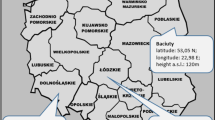Abstract
Using the alternative renewable process and run theory, this study investigates the distribution of drought interval time, mean drought interarrival time, joint probability density function and transition probabilities of drought events in the Kansabati River basin in India. The standardized precipitation index series is employed in the investigation. The time interval of SPI is found to have a significant effect of the probabilistic characteristics of drought.


















Similar content being viewed by others
References
Bussay A, Szinell C, Szentimery T (1999) Investigations and measurements of droughts in Hungary. Hungarian Meterological Service, Budapest
Chung CH, Salas JD (2000) Drought occurrence probabilities and risks of dependent hydrological processes. J Hydrol Eng ASCE 5(3):259–268
Dracup JA, Kendall DR (1990) Floods and droughts. In: Waggoner PE (eds) Climate change and US water resources. Wiley, New York, pp 243–267
Dracup JA, Lee KS, Paulson EG (1980) On the statistical characteristics of drought events. Water Resour Res 16(2):289–296
Fernandez B, Salas JD (1999a) Return period and risk of hydrologic events. I: Mathematical formulation. J Hydrol Eng ASCE 4(4):297–307
Fernandez B, Salas JD (1999b) Return period and risk of hydrologic events. II: Applications. J Hydrol Eng ASCE 4(4):308–316
González J, Valdés JB (2003) Bivariate drought recurrence analysis using tree rings reconstructions. J Hydrol Eng ASCE 8(5):247–258
Guttman NB (1998) Comparing the palmer drought index and standardized precipitation index. J Am Water Resour Assoc 34(1):113–121
Guttman NB (1999) Accepting the standardized precipitation index: a calculation algorithm. J Am Water Resour Assoc 35(2):311–322
Haan CT (2002) Statistical methods in hydrology. The Iowa State University Press, Ames, p 496
Hayes MJ, Svoboda MD, Wilhite DA, Vanyarkho OV (1999) Monitoring the 1996 drought using the standardized precipitation index. Bull Am Meteorol Soc 80:429–438
Hughes BL, Saunders MA (2002) A drought climatology for Europe. Int J Climatol 22:1571–1592
Kendel DR, Dracup JA (1992) On the generation of drought events using an alternating renewal-reward model. Stochast Hydro Hydr 6(1):55–68
Kim T, Valdés JB, Yoo C (2003) Nonparametric approach for estimating return periods of droughts in arid regions. J Hydrol Eng ASCE 8(5):237–246
Kim T, Valdés JB, Yoo C (2006) Nonparametric Approach for Bivariate Drought Characterization Using Palmer Drought Index. J Hydrol Eng ASCE 11(2):134–143
Lana X, Serra C, Burgueño A (1998) Spatial and temporal characterization ofannual extreme droughts in Catalonia (Northern Spain). Int J Climatol 18:93–110
Lana X, Serra C, Burgueño A (1998) Spatial and temporal characterization of annual extreme droughts in catalonia (Northern Spain). Int J Clim 18:93–110
Loaiciga HA, Leipnik RB (1996) Stochastic renewal model of low-flow stream sequences. Stochast Hydro Hydr 10(1):65–85
Mathier L, Perreault L, Ashkar F (1992) The use of geometric and gamma related distributions for frequency analysis of water deficit. Stochast Hydro Hydr 6(4):239–254
McKee TB, Doesken NJ, Kleist J (1993) The relationship of drought frequency and duration to time scales. In: Preprints, 8th conference on applied climatology, Anaheim, California, 17–22 January 1993, pp 179–184
Medhi J (2002) Stochastic models in queueing theory, 2nd edn. Academic Press, New York, p 450, ISBN 0-12-487462-2
Mishra AK, Desai VR (2005a) Spatial and temporal drought analysis in the Kansabati River Basin, India. Int J River Basin Manage IAHR 3(1):31–41
Mishra AK, Desai VR (2005b) Drought forecasting using stochastic models. Stochast Environ Res Risk Assess 19:326–339
Mishra AK, Desai VR (2006c) Drought forecasting using feed-forward recursive neural network. Ecol model 198:127–138
Palmer WC (1965) Meteorological drought. Research paper no. 45, US Department of Commerce, Weather Bureau, Washington, DC
Redmond KT (2000) Integrated climate monitoring for drought detection. In: Wilhite DA (eds) Drought: a global assessment. Routledge, pp 145–158
Ross SM (2000) Introduction to probability models. Harcourt India Pvt. Ltd, New Delhi
Salas JD (1993) Analysis and modeling of hydrologic time series. In: Maidment DR (eds) Handbook of hydrology, McGraw Hill, New York, pp 19.1–19.72
Sen Z (1976) Wet and dry periods of annual flow series. J Hydrol Div ASCE 106(HY1):99–115
Shiau JT, Shen HW (2001) Recurrence analysis of hydrologic droughts of differing severity. J Water Resour Plan Manage ASCE 127(1):30–40
Stedinger JR, Vogel RM, Foufoula-Georgiou E (1993) Frequency analysis of extreme events. In: Maidment DR (eds) Handbook of hydrology, McGraw Hill, New York, pp 18.1–18.66
Steinemann A (2003) Drought indicators and triggers: a stochastic approach to evaluation. J Am Water Resour Assoc 39(5):1217–1233
Szalai S, Szinell C (2000). Comparison of two drought indices for drought monitoring in Hungary – a case study, In: Vogt JV, Somma F (eds) Drought and drought mitigation in Europe, Kluwer, Dordrecht, pp 161–166
Wilhite DA, Rosenberg NJ, Glantz MH (1986) Improving federal response to drought. J Clim Appl Meteorol 25:332–342
Wolff RW (1989) Stochastic modeling and the theory of queues. Prentice-Hall Inc., Englewood Cliffs
Yevjevich V (1967) An objective approach to definitions and investigations of continental hydrologic droughts. Hydrol. Papers 23, Colorado State University Publication, Colorado State University, Fort Collins, Colorado, USA
Yue S (1999) Applying bivariate normal distribution to flood frequency analysis. Water Int IWRA 24(3):248–254
Zelenhastic E, Salvai A (1987) A method of streamflow drought analysis. Water Resour Res 23(1):156–168
Zhang L, Singh VP (2006) Bivariate flood frequency analysis using the copula method. J Hydrol Eng ASCE 11(2):150–164
Author information
Authors and Affiliations
Corresponding author
Rights and permissions
About this article
Cite this article
Mishra, A.K., Singh, V.P. & Desai, V.R. Drought characterization: a probabilistic approach. Stoch Environ Res Risk Assess 23, 41–55 (2009). https://doi.org/10.1007/s00477-007-0194-2
Published:
Issue Date:
DOI: https://doi.org/10.1007/s00477-007-0194-2




